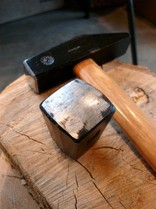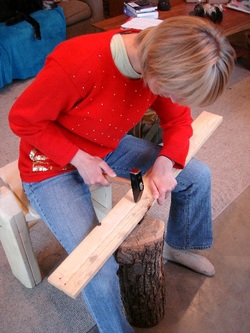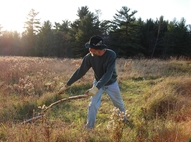"Übung macht den Meister."  Freehand peening is much easier to learn, if you grew up using a hammer of some sort. I remember learning how to use a hammer as a young boy, from my Dad, and also from my neighbor who was a carpenter. It took a lot of practice for a young kid, to develop the hand-eye co-ordination necessary, to smoothly pound a nail straight into the wood, without missing the nail or damaging the wood. Whenever my Dad, or my neighbor was working on a carpentry project, I would be given some scrap wood, some nails, and an old hammer, to keep me busy and out of the way, but also to help me learn how. I was encouraged to practice. Learning how to use a hammer was considered an essential skill. However, that was back in the days before cordless drills, and pneumatic nail-guns. Now, even I seldom use a regular hammer, other than to occasionally hang pictures, or pound in fencing stakes. For most projects, I use screws and a cordless drill, because that way I can take it apart someday, and re-use all the materials. Cordless drills and pneumatic nail-guns have become so common place, that my local farm store recently put most of their nails on clearance. I still know how to use a hammer, however, and I assumed that everybody else does as well. It's such a simple skill. To my surprise, when I first started to teach peening, I discovered that many people didn't even have the basic hammering skill needed to hit a nail. Alarmingly, when they started to peen, they would enthusiastically start hitting the blade all over the place. "Whoa, whoa, whoa!", was my reaction. This prompted me to add the following section on hammering skill, to my 1SR peening manual (included in my peening kits): "Even though I claim that my peening method is almost as easy as using a peening jig, you do have to have some basic skill with a hammer. If you can't hit a nail, neither method will be easy. A peening jig requires much less accuracy, but it requires that you to hit with a lot more force, than you do when free-hand peening. You need to hit with a consistent force with either method. With a peening jig you also have to move the blade through the jig very evenly, which is difficult to do, because you can't see what is happening with the cap obscuring your view, and also the blade does not slide through very smoothly. And, because you are striking the cap, which is then in turn striking the blade, you are removed from feeling/seeing the direct result of your actions. By contrast, free-hand peening on a narrow anvil requires less force, but more sensitivity and consistency with the hammer, but you can see and feel the direct result of your action. All things considered, I do not consider the peening jig much of an advantage, and it does not lead to the development of the actual skill required for more advanced peening techniques, such as repairs." If you have not used a hammer much before, I suggest getting a scrap piece of 2x4 lumber, and a box of small nails [1"- 1 1/4" finishing nails are a good size] and practice hammering the nails into it. (Use a carpenters hammer for that, not your peening hammer. Your peening hammer should only be used for peening!) When you can smoothly hammer the nails into the wood, without bending the nail or dinging up the wood, "you will have learned, Grasshopper", and you will be ready to try peening your scythe blade. Assembling new bee-hive frames is also good practice (and more productive!)."  Now when I teach a peening workshop, I ask everyone that hasn't used a hammer much, to practice pounding nails, beforehand. Once they are at my peening workshop, I check their progress, and have them warm up, with this exercise: I put a wide anvil in the peening block and give them a scrap piece of 1x4, with a few straight lines drawn on it. Then I have them them pretend that the board is a scythe blade, and the lines are the edge that they need to peen. I have them hammer a groove into the wood, with the cross-peen end of the hammer. This exercise gives you quick feedback on the accuracy of your hammer strike, and the consistency of how hard you are hitting with each strike. With consistencey and accuracy you can form a smooth and even groove in the wood. The hammering form for this exercise is the same as for the Compressing Hammer Strike (see the 1SR peening manual), so I have beginner's start out with that hammering strike when they first attempt to peen an actual scythe blade on a narrow anvil. This exercise is also good for developing greater accuracy with the cross-peen end of the hammer, before attempting to repair a blade that has a crack, or if you want to learn how to peen "old-school" with a cross-peen hammer and a wide anvil. Peening is the key to success with using an Austrian scythe. If you are intimidated by the idea of learning how to peen a scythe blade, I suggest to first have some fun, and practice pounding nails with a regular hammer, to develop some basic skill and confidence. Next try "peening" on a wooden board. Have fun with it, and enjoy the satisfaction of seeing your co-ordination develop, and become confident with a new skill.
0 Comments
Your comment will be posted after it is approved.
Leave a Reply. |
Botan AndersonArchives
March 2023
Categories
All
|

 RSS Feed
RSS Feed